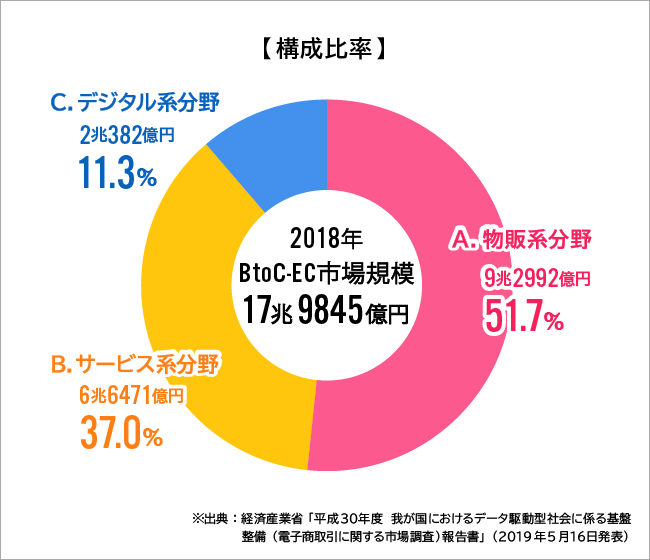Shopping is available 24 hours a day. It saves the hassle of going to a store, and you can get any product from around the world.
E-commerce (EC), or online shopping, has become commonplace thanks to the proliferation of smartphones. Consequently, intense attention is now focused on "EC platforms as advertising markets."
Three Dentsu Group companies (D2C Inc./CCI/Dentsu Inc.) estimated Japan's 2018 advertising expenditure on merchandise-based e-commerce platforms and released projections for 2019 ( see press release ). Toshiyuki Kitahara of Dentsu Media Innovation Lab explains the background behind this market expansion.
2018 Advertising Spending on Product-Selling E-Commerce Platforms: ¥112.3 Billion
Interest in advertising on e-commerce platforms is growing. Dentsu Group's " 2018 Japan Advertising Expenditure " report released this year also highlighted the topic of "increasing advertising on e-commerce platforms."
According to estimates by the Ministry of Economy, Trade and Industry, the domestic B2C e-commerce (consumer-facing electronic commerce) market size in 2018 was ¥17,984.5 billion (109.0% year-on-year).
Of this, merchandise sales accounted for ¥9,299.2 billion (108.1% year-on-year), service sectors like food/drink and travel accounted for ¥6,647.1 billion (111.6% year-on-year), and digital sectors like games and e-publishing accounted for ¥2,038.2 billion (104.6% year-on-year).
In terms of composition, goods sales accounted for 51.7% of the entire EC market, representing nearly half. This was followed by services at 37.0% and digital at 11.3%.
In response to this situation, the Dentsu Group focused on the merchandise sales segment—the largest and fastest-growing area within the booming B2C e-commerce market, where advertising and promotional activities are expanding—and conducted an estimated survey of "Advertising Expenditures on Merchandise Sales E-Commerce Platforms" (*).
*This survey estimates advertising expenditures on product-based (goods sales) e-commerce platforms, including home appliances, miscellaneous goods, books, clothing, and office supplies. Advertising expenditures on platforms for travel services, financial services, ticket sales, food and beverage services, beauty and hair services, online games, digital publishing, and paid video/music streaming are excluded.
As a result, we estimated the 2018 advertising expenditure on merchandise-based e-commerce platforms to be ¥112.3 billion, a 120.6% increase from the previous year.
While the growth rate for internet advertising in "2018 Japan Advertising Expenditures" was 118.6%, advertising expenditure on goods-selling e-commerce platforms showed a higher rate of growth, indicating rapid expansion.

Scope of estimation: Annual transaction value of advertisements transacted primarily on e-commerce platforms selling goods.
For 2019, the forecast for e-commerce platform advertising spending anticipates further acceleration in growth, expanding to ¥144.1 billion with a year-on-year growth rate of 128.3%.
The purpose of this survey was to grasp the approximate scale of the highly scrutinized product-selling e-commerce platform advertising market. Moving forward, we plan to conduct detailed analysis and consider how to incorporate this data within "Japan's Advertising Expenditures."
Background and Future Outlook for EC Platform Advertising
Today, virtually all goods and services are bought and sold online, with a significant portion of consumer behavior occurring via the internet. This trend is driving a shift in corporate marketing and advertising activities, a shift clearly reflected in the high growth rate of advertising spending on e-commerce platforms.
Advertisements displayed on e-commerce platforms offer the distinct advantage of placing messages close to where products are actually sold and where consumption occurs. This benefit is highly valued by corporate advertisers.
The fundamental principle of advertising is "to place ads where customers are," and e-commerce platforms are increasingly fulfilling a role akin to in-store promotions or OOH advertising.
Another factor is that while online advertising faces issues like ad fraud, viewability, and brand risk, being able to place ads on trusted e-commerce platforms provides a sense of security.
Currently, most ads on e-commerce platforms—whether for products or services—are primarily linked to "site search." However, we expect an increase in data-driven, programmatic advertising tied to user behavior. We foresee an advertising business model linked to user search and purchase histories, where e-commerce platforms become integral to corporate advertising and sales promotion planning.
As major players and many other e-commerce platform operators actively expand their advertising businesses, companies are also expected to increasingly utilize data from e-commerce platforms in various ways to deepen their digital marketing efforts.





